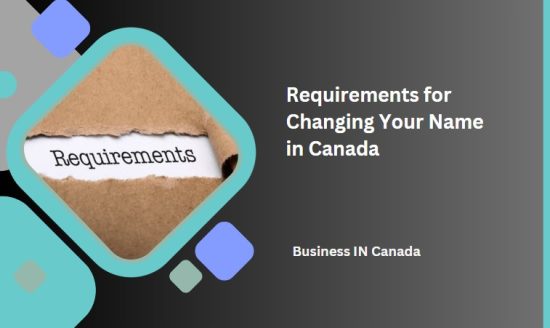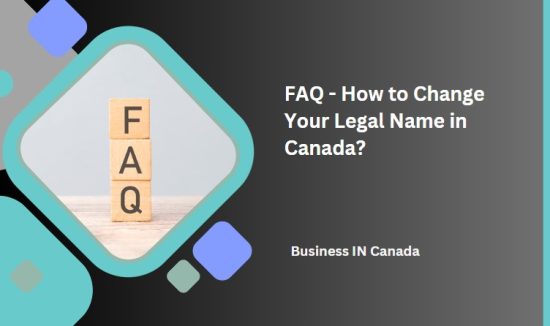Are you considering changing your legal name in Canada? Maybe it’s because you got married, divorced, or want a fresh start. Whatever the reason, changing your name is a significant decision that requires proper guidance and understanding of the process. In this blog post, we will walk you through everything you need to know about how to change your legal name in Canada.
We’ve covered you, from the different types of name changes to the requirements and application process! So let’s dive in and get started on this exciting journey towards a new identity.
How to Change Your Legal Name in Canada?

The process of changing your legal name in Canada can be a bit overwhelming but don’t worry; we’re here to help. The first step is to determine the type of name change you need. There are several types of name changes available depending on your circumstances.
If you’ve recently gotten married or divorced and want to take on your spouse’s last name or revert to your maiden name, then a marriage certificate or divorce decree will suffice as legal proof for the change.
On the other hand, if you want to change your first or middle name legally, you’ll need a court order. This typically requires filing an application with your residence’s provincial/territorial government.
Once you have determined what type of change is required for your situation, it’s time to gather all necessary documents and fill out any required forms accurately. You may also need fingerprinting done for security reasons depending on where in Canada this takes place.
After submitting the application and materials needed (including payment), processing times can vary from province to province: anywhere from six weeks up until several months!
While changing one’s legal name in Canada may seem quite an undertaking initially – especially when considering how long it can take – following each step outlined above closely will ensure that things go smoothly during this exciting transition period!
Types of Name Changes Include
There are several types of name changes that you can request in Canada. The most common type is a legal name change, which involves changing the first and last name on your birth certificate. This type of name change requires a court order.
Another type of name change is a marriage-related name change. If you get married or enter into a common-law relationship, you can assume your partner’s last name without going through the legal process.
Another option is to hyphenate your current last name with your spouse’s last name after marrying or entering into a common-law relationship. For example, if your last name is Smith and you marry someone whose last name is Jones, you could become Smith-Jones.
You may also be able to make minor spelling changes to your first or last names without needing a court order. These changes usually involve correcting typos on official documents like passports or driver’s licenses.
It’s important to note that changing your gender marker on official documents like birth certificates and government-issued IDs requires a separate process from changing your legal or marital name.
Requirements for Changing Your Name in Canada

Before you begin changing your name in Canada, it’s important to understand the requirements. Firstly, you must be at least 16 years old and a Canadian citizen or permanent resident. If you’re under 16, you’ll need both parents’ and legal guardians’ written consent.
You also cannot change your name for fraudulent purposes or to avoid debts or other obligations. Additionally, if there is any pending legal action against you or if you have a criminal record, this may affect your ability to change your name.
Next, it’s important to note that each province and territory has specific requirements for changing names. For example, some provinces require fingerprints and background checks while others do not.
In terms of documentation required for the application process, a birth certificate or citizenship card is typically needed, as well as two pieces of government-issued identification, such as a passport and driver’s license.
Understanding these requirements can make the name change process smoother and more successful.
How to Apply for Name Change in Canada?

Applying for a name change in Canada is not as complicated as one might think. The process varies depending on your province or territory but generally involves filling out an application form and submitting it to the appropriate government agency.
The first step is to obtain a legal name change application form from your provincial or territorial government website. You will need to provide personal information such as your current legal name, the reason for the name change, and the proposed new name. It’s important to fill out all sections of the form accurately and honestly.
Once you have completed the application form, you must have it signed by a commissioner of oaths or notary public before submitting it, along with any required documents such as birth certificates, marriage licenses, or divorce decrees that support your request for a name change.
After submission of the paperwork and paying any applicable fees (which vary by province), you can expect to receive an official certificate reflecting your new legal name within four to six weeks.
It’s important to note that there are some restrictions on what names are allowed in Canada. For example, names cannot be offensive or misleading. Additionally, if changing a child’s last name due to separation/divorce proceedings, then both parents would require consent/permission/approval from each other before proceeding with this request.
Cost of Name Change

When it comes to changing your legal name in Canada, one of the major considerations is undoubtedly the cost. The fees for a name change can vary depending on different factors, such as where you live and whether or not you’re changing your first or last name.
Most provinces and territories generally require a fee for processing a name change application. For example, in Ontario, the current fee is $137 for an adult’s legal name change. Additional costs may also apply if you need to order new identification documents like a driver’s license or passport with your new name.
It’s important to note that some individuals may be eligible for a fee waiver if they can demonstrate financial hardship. Each province has its own guidelines regarding fee waivers, so it’s best to check with your local government website or agency.
While the cost of changing your legal name in Canada isn’t insignificant, it’s important to weigh this against the potential benefits of having a new identity that better reflects who you are as an individual.
How Long Does to Change a Name in Canada?
Changing your name in Canada is a process that requires patience and time. The length of the process depends on various factors, including the province or territory you live in and the reason for changing your name.
In most provinces and territories, legally changing your name takes about 4-6 weeks. However, some provinces like Ontario may take up to 8 weeks due to their strict requirements for verification of identity. It’s important to note that this doesn’t include any additional waiting periods if there are issues with your application or if you need to provide further documentation.
To ensure a smooth and timely process when changing your legal name, it’s essential that you gather all necessary documents beforehand. This includes a completed application form, proof of identification, marriage certificate (if applicable), divorce decree (if applicable), and any other supporting documents required by your province or territory.
Once you’ve gathered all necessary documents, submit them along with the application fee at the appropriate office in your province or territory. After submitting everything correctly, sit tight as you wait for government confirmation regarding your new name’s approval came.
Be patient during this process, as it can sometimes take longer than expected, but following these steps will help make sure that things go smoothly!
Conclusion
After changing your legal name in Canada, it’s important to remember that this is a significant step and should not be taken lightly. You may experience various emotions during the process, such as excitement, anxiety or even frustration due to any delays or unexpected challenges.
However, you can successfully change your legal name in Canada with patience and persistence. It’s crucial to follow all the steps and requirements outlined by the government agencies responsible for processing name changes.
It’s also vital to notify all relevant authorities about your new legal name once it has been approved. This includes updating your identification documents, notifying your employer if applicable, and informing financial institutions such as banks and credit card companies.
Remember that changing your legal name does not mean altering who you are but rather reflects a personal preference that will allow you to move forward confidently in life with an identity that better represents you.
While changing one’s legal name can seem daunting at first, it is achievable when approached systematically. Remain patient throughout each stage of the application process and stay focused on achieving your goal.
FAQ – How to Change Your Legal Name in Canada?

How much does it cost to legally change your name in Canada?
Changing your legal name in Canada can be an exciting and important step towards a fresh start, but it’s understandable to wonder about the associated costs. The cost of changing your legal name in Canada varies based on where you live and the type of name change you’re seeking.
Generally, the legal name change fees range from $100 to $300. These fees cover administrative costs such as processing applications and issuing new identification documents like birth certificates or driver’s licenses.
It’s worth noting that additional costs may arise if you require certified copies of documents or need to publish a notice of your name change in local newspapers. You should also consider any potential expenses related to updating personal records, such as bank accounts and credit cards.
While changing your legal name in Canada may seem daunting at first glance, it’s a manageable expense for most individuals seeking this life-changing transition.
Can a name change be denied Canada?
In Canada, changing your legal name is a relatively straightforward process. However, there are certain circumstances where the government may deny a name change.
One common reason for denial of a name change request in Canada is if the new name is considered offensive or inappropriate. This can include names that promote hate speech or discrimination against protected groups such as race, gender, sexuality, or religion.
Another reason for denial can be due to criminal history. If an individual has been convicted of certain crimes, such as fraud or identity theft, their application for a name change may be denied.
It’s important to note that the decision to deny a name change request ultimately lies with the Registrar General’s office in each province and territory. They have the authority to review and approve all legal name changes within their jurisdiction.
If your application for a legal name change has been denied in Canada, you may have options available to appeal the decision through administrative processes or seek legal counsel.
How long does a name change take?
Changing your legal name in Canada can take four to eight weeks, depending on various factors. One significant factor is the province or territory where you reside, as each has different processing times.
Generally, the first step involves filing an application with the appropriate government agency and obtaining a criminal record check. The processing time for these steps may vary depending on how quickly you submit all required documents.
Once your application is approved, it will be published in local newspapers to inform the public about your name change intentions. This publication period typically lasts four to six weeks.
After this stage, additional paperwork may need to be filed before receiving official approval of your new name. Once everything is completed successfully, you’ll receive documentation indicating your legal name change.
It’s essential to start this process well ahead of any important deadlines, as it can take some time to complete and receive all necessary approvals.
Who do you notify when you change your name Canada?
Once you’ve legally changed your name in Canada, there are several people and organizations that you need to notify. This ensures that your new name is reflected on all official documents and records.
Firstly, updating your identification documents like your driver’s license, passport, health card, and SIN card is important. You can do this by visiting the nearest Service Canada or Ministry of Transportation office with proof of your legal name change.
Next, don’t forget to inform any financial institutions where you hold accounts, such as banks and credit unions. They will require a copy of your legal name change document along with other identification documents.
It’s also necessary to update any existing contracts, including rental agreements or car loans, under the old name so that they reflect the new one. Notify utility providers like hydro companies, phone providers etc., so that bills come under the correct name.
Notify anyone who may be sending mail addressed to you at home, such as employers or insurance companies. By notifying all relevant parties about your legal name change in a timely manner, you’ll avoid confusion down the road!
Can we change the name in bank account?
The answer is yes. The process of changing your bank account’s name may vary depending on the bank. Some banks may require additional documentation or charge fees for changing names on accounts. It’s best to contact your bank directly and ask about their specific procedures for changing account names.
Changing your legal name in Canada doesn’t have to be complicated as long as you follow the steps outlined above. Whether you’re getting married, divorced, or simply looking for a fresh start with a new identity, knowing how to legally change your name is an important step towards achieving that goal.










